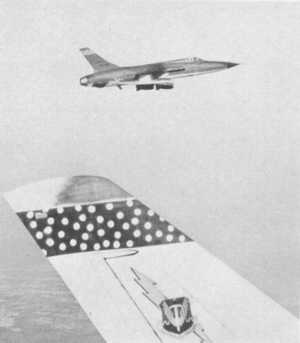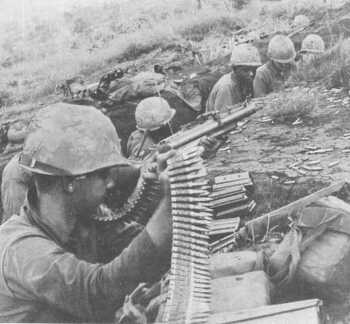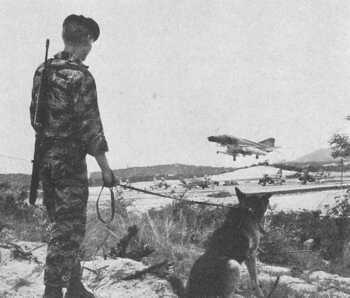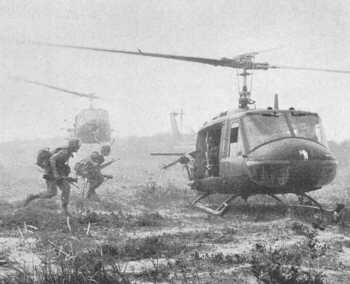
This is a direct reproduction of the original content of ALL HANDS magazine.
©All Hands Magazine, Inc. All rights reserved. Reproduction by permission only.
Navigate through the "pages" by clicking on the page numbers, next or back links at the bottom of your screen or by clicking the links in the Table of Contents.

SURVIVAL FOOD may never rival the cookery of a cordon bleu. However, it may be considerably improved by new preservation methods now being developed by the Army.
The new process involves packaging food, then giving it a small dose of gamma rays from a cobalt-60 source. No radiation remains in the treated food product which is as healthful and wholesome as any beat-processed food.
Consequences of this procedure could be widespread. Refrigeration needs would be reduced with consequent lower food losses through spoilage.
Better control of food-borne disease would also be achieved and more fresh meats and vegetables would be available to field units in combat.
Tasty dinners, could be included in survival kits and the traditional C-ration could be relegated to a museum case as a memento of the military past.
* *
*
AIR RECONNAISSANCE men may soon see the image their cameras record
even before their plane lands. Such speed seems possible with an experimental
film processing system which was developed for the Air Force Avionics
Laboratory at Wright-Patterson Air Force Base, Ohio. The new system
produces a high quality negative and a positive transparency-all within 30
seconds. Because a positive photographic image is produced so quickly,
the pictures can be scanned while the plane is still in the air, then
jettisoned to the ground or made available to photo interpreters as soon as the
plane lands. The process can be used in black and white. Other emulsions could
be processed by this technique, including infrared and aerial color
photography. Black and white positive transparencies can be made
almost immediately using a portable processor six feet long and one foot
square. A film-like material is brought in contact or laminated with an exposed
negative material. When peeled apart after a brief interval, both the positive
print and negative are available. The new technique uses a polyester
film base which carries a gelatin layer containing a developer. Before film is
processed, it must be soaked with one of several processing solutions called
imbibants. The imbibants contain chemicals which develop and fix the negative
then transfer the positive image to the film. No further processing is
required.
* *
*
* *
*
IF IT TESTS out successfully, an experimental vertical short takeoff
and landing (V/STOL) aircraft with a substantial cargo capacity may
revolutionize air transport by making a forest clearing as good for landing
cargo as a multi-million dollar runway complex. The plane being tested
is the XC-142A, a V/STOL triservice transport. So far, it has been able to
carry dummy cargo loads weighing as much as 4000 pounds and drop them either
while hovering only five feet above the ground or while flying forward at 30
knots. Dumping cargo is the plane's forte. It does this either while
flying at low speeds or hovering with the fuselage tilted upward several
degrees. The cargo, which is mounted on rollers, slides out the rear end of the
aircraft to a comparatively easy landing on the ground a few feet below. The plane was developed for use in brushfire warfare where wide dispersion
of units and rapid delivery of troops and supplies to remote areas required new
techniques in logistics. In addition to its military application, the
XC-142A could bring a radical change to civilian air transport by making the
smallest town accessible to air cargo deliveries. The change could
even be felt in large cities where air cargoes need not necessarily be
delivered hours away from their ultimate destination.
The XC-142A was designed to carry 32 fully equipped combat troops or
8000 pounds of cargo at a combat radius of 200 nautical miles. When it uses
special fuel tanks inside the cargo space, the plane has a ferry range of over
2600 nautical miles and requires only a short 680 feet for takeoff. It lands
vertically upon arrival at its destination.
In terms of payload, the XC-142A could carry a variety of payloads
including: Components of tactical missile systems; a one and one-quarter ton
truck; 32 troops; 24 litter patients; large palletized cargoes; or many other
weapons orcombinations.
Despite its large cargo carrying ability, the XC-142A has a wingspan
of 67 and one-half feet, an over-all length of 58 feet, and a height of 26
feet. The troop and cargo compartment is 30 feet long, seven and one-half feet
wide and seven feet high.
* *
*
THE ARMY'S OV-1 Mohawk set five world records for its class,
according to claims filed with the Federation Aeronautique Internationale
(FAI). The surveillance aircraft is in a new category which the FAI established
to include land-based turboprop planes weighing between 13,227 and 17,636
pounds. In tests made at Long Island, N.Y., the Mohawk was made
to climb 9842 feet in three minutes and 46 seconds. It completed a climb of
19,685 in nine minutes and nine seconds and sustained an altitude of 32,000
feet in horizontal flight. The plane also flew a straight-line,
nonstop-distance course covering 2422 miles in nine hours and 34 minutes -an
average of about 255 miles per hour. The fifth test was a
closed-circuit flight in which the OV-1 covered 100 kilometers at 5000 feet in
12 minutes and 48.8 seconds-an average speed of 292 miles per hour.
The Mohawk is equipped with cameras, side-looking airborne radar and
infrared devices. The Army has used the plane in Southeast Asia since
1962.
* *
*
* *
*
TAXI TO A SPACE STATION, anyone? It may someday be commonplace. That
is the ultimate objective of an Air Force project called START-to develop a
revolutionary, manned wingless rocket plane which can operate between orbiting
space stations and earth to taxi men and materials. The craft would be capable
of normal landings on earth. With the recent letting of a contract to
design and build a one-man version of such a vehicle-technically referred to as
a "lifting body"-the project reached the third of three stages. For several
years, various types of testing and developing under the Spacecraft Technology
and Advanced Reentry Test program were pursued. The rocket ship phase is called
PILOTPiloted Lowspeed Test project. Project PILOT's rocket-powered
vehicle, the SV-5P, will be used to explore the flight characteristics and
maneuverability of wingless lifting bodies in the earth's atmosphere. It will
look like a midget wingless fighter with three tail fins. The top of
the 24-foot-long SV-5P will stand about eight feet above ground. Its long,
bulbous-shaped nose will flare back to three vertical fins which will provide
the necessary airfoil shape for lift normally derived from wings. It will weigh
5000 pounds. Initially, the SV-5P will be carried aloft under the wing
of a B-52 aircraft and dropped for powerless, gliding flights, landing at
Edwards Air Force Base, Calif. In later powered tests, it will be dropped from
the B-52, then rocket to Mach 2 speed at about 100,000 feet, from where it will
again maneuver back to the landing area. Before these manned
experiments take place, however, an unmanned version of the SV-5P will be
boosted to orbital altitude and hypersonic speeds by a booster rocket, then
reenter the earth's atmosphere to be guided to a landing. Research
data and technology obtained from these tests and from other closely related
projects will provide a sound base of engineering knowledge which will be
useful in the design of similar future vehicles.
Page 43



1
2
3
4
5
6
7
8
9
10
11
12
13
14
15
16
17
18
19
20
21
22
23
24
25
26
27
28
29
30
31
32
33
34
35
36
37
38
39
40
41
42
43
44
45
46
47
48
49
50
51
52
53
54
55
56
57
58
59
60
61